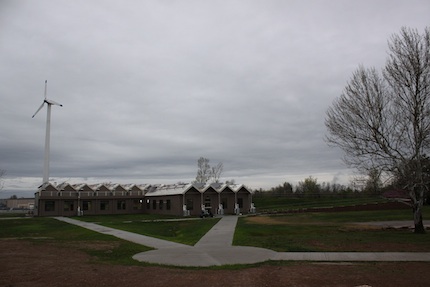Project Profile: Crowder College's 'Role Model' for Green Campus Facilities
- By Bridget McCrea
- 04/24/12
When construction on Crowder College's new Missouri Alternative and Renewable Energy Technology (MARET) Center kicked off in September 2011, the word "green" was on everyone's mind. From the facility's construction materials to its energy sources to it wastewater management, literally every corner of MARET Center's 10,000-square-foot first phase factored in environmentally conscious practices and decisions.
There was a method behind Crowder College's madness: Once built, the Neosho, MO-based school's new MARET Center would serve as a role model for sustainable building statewide. The facility promotes renewable energy use through education, applied research, and economic development. By incorporating wind energy, solar electricity, solar thermal, daylight, and other resources, the building operates as a positive net energy structure by producing more energy from renewable resources than it consumes. It also serves as a "living laboratory" for the educational programs taught at the MARET Center.
Breaking new ground and being first is never easy. To learn what makes MARET so "green" and find out how the facility was planned out, funded, and honed to achieve LEED's highest certification level, Campus Technology spoke with Russell Hopper, the center's executive director.
Bridget McCrea: How did MARET come about?
Russell Hopper: Crowder College was named a MARET Center in 1992, and this new facility is part of that evolution. We were doing a lot nationally with solar powered vehicles at the time and participated in a number of the Department of Energy's solar decathlons. Our local congressman, Roy Blunt, thought it would be good to set funding aside to build a center that would be dedicated to training, applied research, and economic development. In 1999 it became clear to us that we needed a dedicated building if we were going to continue expanding the program and having it serve as a beacon for the demonstration of alternative and renewable energy.

Phase 1 of Crowder College's new Missouri Alternative and Renewable Energy Technology (MARET) Center |
McCrea: How was the project funded?
Hopper: Congressman Blunt's efforts resulted in nearly $3 million in federal funds for the first phase of the project, which included the construction of a 10,000-square-foot facility. We also did our own fundraising and raised an equal amount of money from local private donors.
McCrea: What design and construction considerations went into MARET?
Hopper: My predecessor, Art Boyt, kicked things off by working with local contractors and architects who were located in our area and sustainability-minded. They brainstormed and came up with ideas for systems, equipment, and materials that would go into the building. Throughout the process they strived to incorporate as many sustainable or "green" processes and technologies as possible into the facility. They were also working toward LEED Platinum, the highest green building certification attainable. Those were the core goals during the early planning stages for this facility.
McCrea: What are some of the specific elements that were incorporated?
Hopper: The roof was constructed in a way that maximizes usable space and south-facing surfaces in order to accommodate solar panels. We hooked up a wind turbine that serves our MARET student programs and provides energy for the facility. The building also incorporates two energy-efficient heat savings technologies – insulating concrete forms (ICFs), which have R values that reach as high as 50 and structural insulated panels (SIPs), whose R values go up to 45. The building's envelope incorporates geothermal systems that make the MARET center as efficient as possible in terms of the generating of both heating and cooling. There is no "forced air." Everything is heated and cooled via radiant panels that are housed in the ceilings.
McCrea: What other technology tools went into the building's development?
Hopper: In order to maintain the building's extremely high level of efficiency, every room and zone are monitored by electronic sensors. We can tell when someone enters a room and then we can determine whether or not to add heating or cooling to that previously unoccupied space. The program turns on the actuators automatically and allows heating or cooling to flow to the appropriate panels. The sensors also include CO₂ monitoring and humidity monitoring. Everything is handled from a single location via our sensor control.
McCrea: What hurdles did you run into when designing and building MARET Center?
Hopper: Our biggest challenge was that we were operating in the realm of sustainability and energy efficiency that had never been done before in our state. A number of contractors in our area were skilled at building sustainable commercial, industrial, and residential projects, but they had never really undertaken a project of MARET Center's scale. This is not standard commercial or industrial space. To work through it we basically had to sit down with the architect, engineer, and contractor to try to figure out the requirements for LEED Platinum certification. Even the best HVAC contractor in the area, for example, didn't have any experience installing radiant ceiling panels at the level that we were striving for. It was a learning curve for everyone involved.
McCrea: You moved into the MARET Center in February. How is it going and when will phase two commence?
Hopper: We've only been in the building for a couple of months so we're still in shakedown mode. We think it will take at least one year to identify all of the glitches in the new building. After that we'll incorporate those changes in the design of phase two, which will include another 17,000-square feet building for a total of 27,000 square feet. We haven't started fundraising for the next phase yet so we don't have a timetable in place. When we get the funding we'll move ahead with that new building.